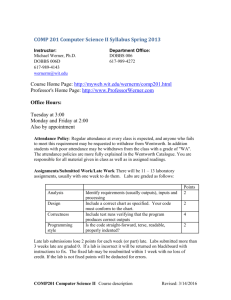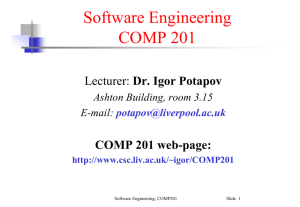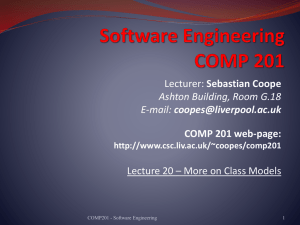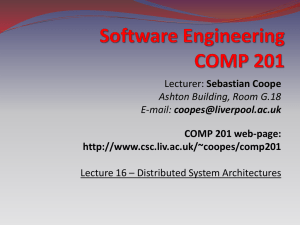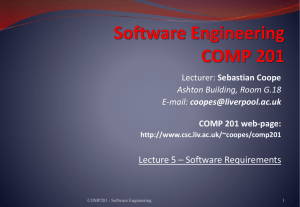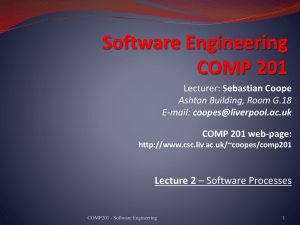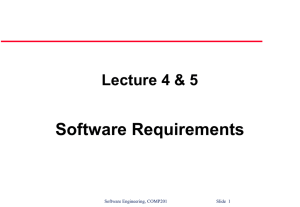Software Requirements
advertisement
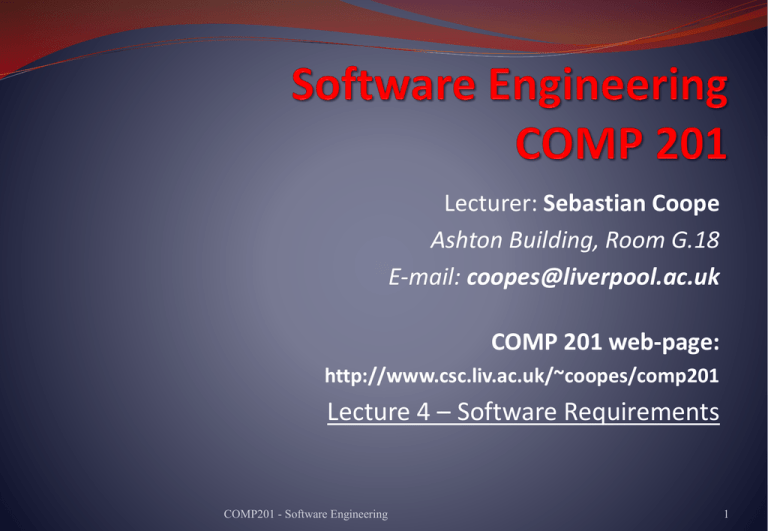
Lecturer: Sebastian Coope Ashton Building, Room G.18 E-mail: coopes@liverpool.ac.uk COMP 201 web-page: http://www.csc.liv.ac.uk/~coopes/comp201 Lecture 4 – Software Requirements COMP201 - Software Engineering 1 Exercise COMP201 - Software Engineering 2 Software Requirements Descriptions and specifications of a system Objectives: To introduce the concepts of user and system requirements To describe functional / non-functional requirements To explain two techniques for describing system requirements To explain how software requirements may be organised in a requirements document COMP201 - Software Engineering 3 Topics Covered Functional and non-functional requirements User requirements System requirements The software requirements document COMP201 - Software Engineering 4 Software Requirements Recall from the last two lectures the following decomposition of the software development lifecycle: General Steps of Software Development: Specifying, Designing, Implementing, Testing. COMP201 - Software Engineering 5 Requirements Engineering Requirements engineering is the process of establishing the services that the customer requires from a system the constraints under which it operates and is developed Requirements The descriptions of the system services and constraints that are generated during the requirements engineering process COMP201 - Software Engineering 6 Why do we need Requirements? To ensure a software solution correctly solves a particular problem, we must initially fully understand the problem that needs to be solved, discover why the problem needs to be solved and determine who should be involved. Poorly defined requirements can cause major problems to a project in both financial terms as well as added time. There are specific techniques we may use in the requirements engineering phase which we shall be considering during the next four lectures. COMP201 - Software Engineering 7 What is a Requirement? It may range from a high-level abstract statement of a service or of a system constraint to a detailed mathematical functional specification This is inevitable as requirements may serve a dual function May be the basis for a bid for a contract - therefore must be open to interpretation May be the basis for the contract itself - therefore must be defined in detail Both of these statements may be called requirements COMP201 - Software Engineering 8 Examples (requirements iteration) The system will support a wide range of the most commonly used graphics file formats The system may support the following file formats: png, jpeg, tiff and giff The system will support the following file formats: png, jpeg, tiff and giff The system may support the following file formats: png, jpeg, tiff and giff, to a maximum resolution of 1024x1024 pixels The system may support the following file formats: png, jpeg, tiff and giff, to a maximum resolution of 1024x1024 pixels COMP201 - Software Engineering 9 Types of Requirement User requirements Statements in natural language plus diagrams of the services the system provides and its operational constraints. Written for customers System requirements A structured document setting out detailed descriptions of the system services. Written as a contract between client and contractor Software specification A detailed software description which can serve as a basis for a design or implementation. Written for developers COMP201 - Software Engineering 10 Examples User requirement We need to be able to spell check documents System requirement The system needs to be able to spell check documents and provide autocorrect facilities. Their will be support for the following languages, English, French and German will plug in support for other languages Software specification CheckResult spellCheck(String word, Dictionary dictionary) Word is defined in UNICODE formatted string The Dictionary structure is defined in S.1.2 The CheckResult is defined in S.1.3 and contains a flag if the word has been found or not, plus a Vector object containing a list of possible other word suggestions depending if the word has been found or not spellCheck will ideally use Hashing tables to improve code efficiency …… COMP201 - Software Engineering 11 Requirements Readers User requirements Client managers System end-users Client engineers Contractor managers System architects System requirements System end-users Client engineers System architects Software developers Software design specification Client engineers (perhaps) System architects Software developers COMP201 - Software Engineering 12 Functional and Non-Functional Requirements Functional requirements Statements of services the system should provide, how the system should react to particular inputs and how the system should behave in particular situations Non-functional requirements constraints on the services or functions offered by the system such as timing constraints, constraints on the development process, standards, etc. Usually defined on the system as a whole Domain requirements Requirements that come from the application domain of the system and that reflect characteristics of that domain COMP201 - Software Engineering 13 Functional Requirements Describe functionality or system services Depend on the type of software, expected users and the type of system where the software is used Functional user requirements may be high-level statements of what the system should do BUT functional system requirements should describe the system services in detail COMP201 - Software Engineering 14 Examples of Functional Requirements All users will access the system using a user id and a password The system shall support the following document formats: PDF, RTF, Microsoft Word 2010 and ASCII text Every order shall be allocated a unique identifier (ORDER_ID) The system have a mechanism to help recover a user’s password COMP201 - Software Engineering 15 Requirements Imprecision Problems arise when requirements are not precisely stated Ambiguous requirements may be interpreted in different ways by developers and users Consider the term ‘recover password’ from previous slide.. User intention – mechanism which allows the user to view the password after going through an authentication procedure Developer interpretation – allowing the user to reset their password so that it can be set again (e.g. using email link) Before development is to commence requirements should be defined as precisely as possible COMP201 - Software Engineering 16 Requirements Completeness and Consistency In principle requirements should be both complete and consistent: Complete They should include descriptions of all facilities required Consistent There should be no conflicts or contradictions in the descriptions of the system facilities In practice, it is very difficult or impossible to produce a complete and consistent requirements document COMP201 - Software Engineering 17 Non-Functional Requirements Define system properties and constraints e.g. reliability, response time and storage requirements. Constraints are I/O device capability, system representations, etc. They are often emergent properties of the system. Process requirements may also be specified, mandating a particular CASE system, programming language or development method Non-functional requirements may be more critical than functional requirements. If these are not met, the system is useless (e.g. key length for encrypting secure email must be >=256 bits) COMP201 - Software Engineering 18 Non-Functional Classifications Product requirements Requirements which specify that the delivered product must behave in a particular way e.g. execution speed, reliability, security etc. Organisational requirements Requirements which are a consequence of organisational policies and procedures e.g. process standards used, implementation requirements, etc. (Java as programming language) External requirements Requirements which arise from factors which are external to the system and its development process e.g. interoperability requirements, legislative requirements, etc. (Must conform to FIPS COMP201 - Software Engineering 19 Non-Functional Requirement Types Non-functional requir ements Product requir ements Ef ficiency requir ements Reliability requir ements Usability requirements Performance requirements Or ganizational requir ements Portability requirements Delivery requirements Space requir ements COMP201 - Software Engineering External requirements Interoperability requirements Implementation requir ements Ethical requirements Standards requirements Legislative requirements Privacy requirements Safety requirements 20 Non-Functional Requirements Examples Product requirement All encryption should use the Advanced Encryption Standard Organisational requirement The system development process and deliverable documents shall conform to the process and deliverables defined in coding and documentation standard XYZCo-SP-STAN-95 External requirement The system shall not disclose any personal information about customers apart from their name and reference number to the operators of the system Performance requirement The system should respond to a user’s request for information in less than 0.1 seconds during “peak-time” and 0.01 seconds during “normal time”. COMP201 - Software Engineering 21 Goals and Requirements Non-functional requirements may be very difficult to state precisely and imprecise requirements may be difficult to verify. Verifiable non-functional requirement A statement using some measure that can be objectively tested Goal A general intention of the user such as ease of use Goals are helpful to developers as they convey the intentions of the system users COMP201 - Software Engineering 22 Examples An example system goal The system should be easy to use by experienced controllers and should be organised in such a way that user errors are minimised. An example verifiable non-functional requirement Experienced controllers shall be able to use all the system functions after a total of two hours training. After this training, the average number of errors made by experienced users shall not exceed two per day. COMP201 - Software Engineering 23 Requirements Measures Property Speed Size Ease of use Reliability Robustnes s Portability Meas ure Process ed trans actions/s econd User/Event respons e time Screen refres h time K Bytes Number of RAM chips Training time Number of help frames Mean time to failure Probability of unavailability Rate of failure occurrence Availability Time to restart after failure Percentage of events causing failure Probability of data corruption on failure Percentage of target dependent statements Number of target systems COMP201 - Software Engineering 24 Requirements Interaction Conflicts between different non-functional requirements are common in complex systems Username/Password mechanism should be easy for user to user All passwords must be hard to guess and ideally require upper/lower case letters and special symbols to ensure high security Which is the most critical requirement? COMP201 - Software Engineering 25 Example Domain Requirement Train Protection System: The deceleration of the train shall be computed as: Dtrain = Dcontrol + Dgradient where Dgradient is 9.81ms2 * compensated gradient/alpha and where the values of 9.81ms2 /alpha are known for different types of train. COMP201 - Software Engineering 26 Domain Requirements Problems Understandability Requirements are expressed in the language of the application domain This is often not understood by software engineers developing the system (e.g. consider the previous slide) would they understand the Physics/Engineering Implicitness Domain specialists understand the area so well that they do not think of making the domain requirements explicit which leads to problems later if software developer implements the requirements in the wrong way COMP201 - Software Engineering 27 User Requirements User requirements should describe functional and nonfunctional requirements so that they are understandable by system users who don’t have detailed technical knowledge User requirements are defined using natural language, tables and diagrams in order that non-technical clients can better understand the requirements and point out potential problems. COMP201 - Software Engineering 28 Problems with Natural Language Lack of clarity Precision is difficult without making the document difficult to read Requirements confusion Functional and non-functional requirements tend to be mixed-up in same document Requirements amalgamation Several different requirements may be expressed together Leads to problems with testing/debugging COMP201 - Software Engineering 29 Guidelines for Writing Requirements Invent a standard format and use it for all requirements Use language in a consistent way. Use shall for mandatory requirements (that must be supported), should for desirable requirements (that are not essential). See RFC 2119 Use text highlighting to identify key parts of the requirement Avoid the use of computer jargon Try and make documents self contained (e.g. include glossaries and complete examples) COMP201 - Software Engineering 30 Lecture Key Points Requirements set out what the system should do and define constraints on its operation and implementation Functional requirements set out services the system should provide Non-functional requirements constrain the system being developed or the development process User requirements are high-level statements of what the system should do COMP201 - Software Engineering 31

